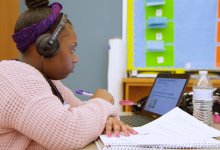Co-teaching With Myself
Creating his own instructional videos allowed one teacher to be in two places at once in his classroom.
Your content has been saved!
Go to My Saved Content.A few years ago, I started using a new teaching strategy with my students when I realized that my beginner string orchestra classes were too big for me to address every student-musician’s musical development and facilitate a rewarding ensemble experience at the same time.
The early days of learning an instrument are extremely challenging, and a music teacher has the narrowest of windows to get student-musicians set up for success before they start to lose interest. So, I had to act quickly and effectively to solve this particular problem in time.
Essentially, I needed a way to duplicate myself, and “co-teaching with myself” was born. While this method has worked wonderfully for me as a music teacher, it can be very helpful for teachers in any discipline who feel that their students need a little extra support during class time.
Introducing ‘Cyber-Teachey’
I began creating instructional videos for specific mini-lessons and activities so that I could break my classes into two halves that would rotate halfway through our 75-minute period.
One half had access to what I called “Cyber-Teachey” in the form of instructional videos that I specifically formatted like the YouTube and Twitch videos I saw my student-musicians watching during lunch. These videos walked my student-musicians through relatively independent musical tasks, like note-reading, rhythm counting, and other music theory fundamentals. The other half got significantly closer support from me in their first days of learning the violin, viola, or cello.
When two teachers engage in this same process within the Integrated Co-Teaching (ICT) model, it’s called station teaching. It’s a terrific strategy when a second teacher is available. However, the absence of a second teacher didn’t stop me when it became clear that my student-musicians needed the smaller student-to-teacher ratio afforded by station teaching. That was where Cyber-Teachey came into play.
I posted the videos to YouTube, where students could watch with closed captioning turned on and at whatever playback speed they needed. The assignment associated with each video could be found linked in the video description and submitted via email or Google Classroom so that I could keep track of and celebrate each student’s progress. I made each sequential lesson available to all of the students at once so that they could pace themselves without any additional guidance from me.
All of these steps freed me up to focus on my small-group instruction. My student-musicians and I got to know each other much better in the early days of the semester in their small groups, as I spent less time managing a large class and more time really teaching.
Later on in the semester, as my student-musicians gained more facility with their instruments, I programmed class periods here and there with about 50 minutes’ worth of independent practice in note-reading—self-paced and guided once again by Cyber-Teachey—and 25 minutes of string sectionals for each instrument section, so that violins could work closely on their parts and violas could focus on theirs, etc. Student-musicians could then develop their theory skills in the two-thirds of class during which the other two sections were practicing their instrumental skills.
Diving Deeper Into Blended Learning
A year later, I had a new problem to solve. I was questioning whether I would continue teaching music production to my 10th and 11th graders, as my instruction didn’t seem to be working.
The technical nature of the discipline and class was proving a stumbling block as I stood at the computer hooked up to the projector at the front of the room and attempted to “I do, we do, you do” my way out of a seemingly impossible quandary. Some students picked up the procedures I was demonstrating right away and started acting up with their friends out of boredom, while others missed a key detail and needed me to go back a few steps at a time.
It was in the midst of this debate I had with myself over whether or not I could teach this class again that I landed on the idea of trying out the co-teaching with myself approach with this class. In this case, it would not be the Station Teaching ICT model, but the One Teach One Assist or One Teach One Observe model, depending on how smoothly things were running with the instructional videos and the music production software.
In these cases, one teacher is the lead teacher, and the other circulates either to discreetly help students or to collect data as students work. The lead teacher, Cyber-Teachey in this case, teaches the lesson through the video. Meanwhile, real-life Teachey is able to walk around and troubleshoot tech issues and, especially later on in the semester, address creative challenges on a more individualized basis.
Today, I keep co-teaching with myself at the top of my teaching tool kit because it’s so effective in solving a broad range of problems in the classroom. Regardless of the subject you teach, if you’ve ever wished you could be in two places at once within your classroom, doing two different things, you might very well find this strategy helpful.

